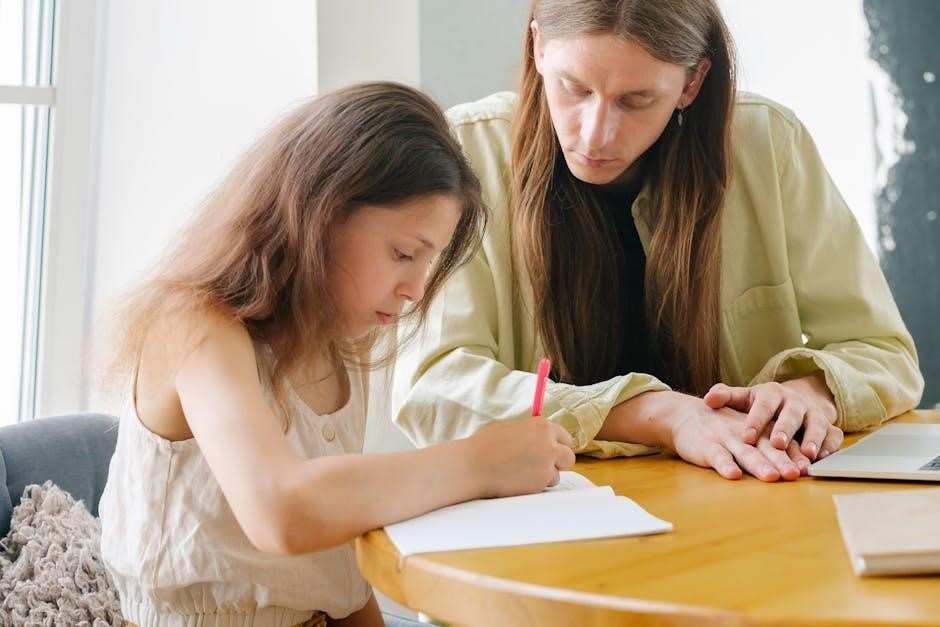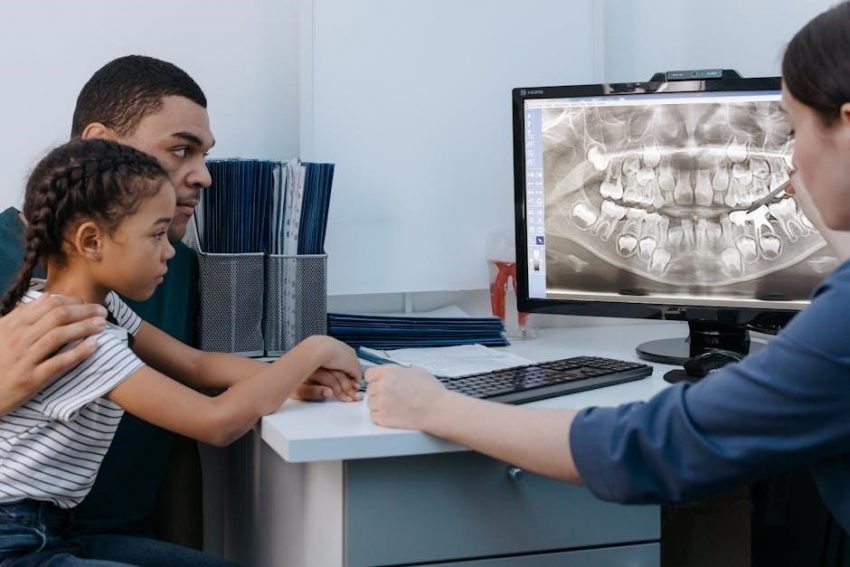Explaining ADHD to a child is a vital step in fostering their understanding and empowerment. This guide provides parents with compassionate strategies to help their child cope with challenges and thrive.
1.1 What is ADHD?
ADHD stands for Attention Deficit Hyperactivity Disorder, a condition that affects how the brain regulates attention, behavior, and activity levels. It is not a deficit in intelligence but rather differences in brain development and function. Children with ADHD may struggle with staying focused, controlling impulses, and sitting still. It is important to explain that ADHD is not something they can “snap out of” but a common condition that many people live with and manage successfully. Understanding this helps reduce stigma and fosters a positive mindset for coping with challenges.
1.2 Why is it Important to Explain ADHD to a Child?
Explaining ADHD to a child is crucial for fostering understanding, self-acceptance, and empowerment. It helps reduce stigma and confusion, allowing them to make sense of their experiences. When children understand their ADHD, they can better manage their challenges and embrace their strengths. This open dialogue also encourages honesty and trust, creating a supportive environment for growth. By explaining ADHD clearly, parents help their child build confidence, develop coping strategies, and understand that their differences are not weaknesses. This foundation of knowledge and acceptance is key to helping them thrive and navigate their unique journey with resilience and positivity.

Understanding ADHD
ADHD is a neurodevelopmental disorder affecting attention, impulse control, and hyperactivity. It involves differences in brain development, leading to challenges in focusing and self-regulation, not a defect.
2.1 The Brain Science Behind ADHD
The brain of a child with ADHD functions differently, particularly in areas responsible for attention and impulse control. Research shows that differences in brain structure and neurotransmitter levels, such as dopamine, can affect focus and behavior. Unlike neurotypical brains, ADHD brains may struggle with regulating stimuli, leading to distractions and hyperactivity. This unique brain chemistry isn’t a flaw but rather a natural variation that impacts how information is processed. Understanding this helps parents and children view ADHD as a manageable condition rather than a deficit, fostering empathy and effective strategies for daily life and learning environments.
2.2 Common Symptoms of ADHD in Children
Children with ADHD often exhibit symptoms like difficulty staying focused, impulsivity, and excessive energy. They may struggle to complete tasks, listen when spoken to, or wait their turn. Impulsive behaviors, such as interrupting others or acting without thinking, are common. Hyperactivity can manifest as fidgeting, running, or an inability to sit still. These symptoms can vary in severity and impact daily activities, such as schoolwork, social interactions, and home life. Understanding these signs helps parents and caregivers provide appropriate support and strategies to manage challenges effectively while fostering a positive environment for their child.
2.3 Strengths and Positive Traits Associated with ADHD
Children with ADHD often possess unique strengths and positive traits. They may exhibit heightened creativity, think outside the box, and approach problems with fresh perspectives. Their energy levels can drive enthusiasm and passion in activities they find engaging. Many children with ADHD are naturally resilient, adaptable, and capable of thinking on their feet. These traits, when nurtured, can lead to remarkable achievements. For example, entrepreneurs, artists, and innovators often credit ADHD for their creativity and drive. By focusing on these strengths, parents can help their child build confidence and view ADHD as a source of potential rather than a limitation.
Preparing for the Conversation
Preparing for the conversation involves choosing a calm setting, using simple language, and addressing fears. It helps the child feel secure and understand their experience better.
3.1 Choosing the Right Time and Place
Choosing the right time and place is crucial for a productive conversation. Opt for a quiet, comfortable environment where your child feels safe and distracted. Avoid moments when your child is upset or preoccupied. Timing is key to ensuring they are receptive to the discussion. A calm atmosphere fosters openness and understanding, allowing your child to process the information effectively. By selecting the right setting, you create a foundation for a supportive and empathetic dialogue about their ADHD.
3.2 Using Simple and Clear Language
Using simple and clear language is essential when explaining ADHD to a child. Avoid complex terms or medical jargon that might confuse them. Instead, use relatable examples and straightforward explanations. For instance, comparing their brain to a “busy airport” helps illustrate how their thoughts can feel overwhelming. Keep sentences short and direct, ensuring your child can grasp the concepts easily. Positive and encouraging language fosters a sense of understanding and reduces any potential shame; By simplifying your words, you make the conversation more accessible and empowering for your child.
3.3 Addressing Your Child’s Fears and Questions
Addressing your child’s fears and questions is crucial to building trust and understanding. Create a safe, empathetic space where they feel comfortable expressing their feelings. Listen without judgment and provide honest, reassuring answers. For example, if they worry about being “different,” explain that ADHD is a common condition and doesn’t define their worth. Use relatable examples, like comparing their brain to a “busy airport,” to help them understand their experiences. Encourage open communication and validate their feelings, ensuring they know they are loved and supported. This approach fosters resilience and helps them view ADHD as a manageable part of their life.

Tailoring the Explanation for Different Ages
Adapt your explanation to suit your child’s age and understanding. Use simple, relatable examples for younger children and more detailed discussions for older kids to ensure clarity and engagement.
4.1 Explaining ADHD to Young Children
For young children, use simple and engaging explanations. Compare their ADHD brain to a busy airport, where signals can get mixed, causing distractions. Emphasize strengths like creativity and energy. Use relatable examples, such as a playful dog, to illustrate impulsivity and distractibility. Keep language positive, focusing on how their brain works differently, not poorly. Highlight their unique qualities and reassure them that they are loved and supported. Encourage open communication to build trust and understanding, fostering a supportive environment for their growth and self-acceptance. This approach helps young children feel confident and valued as they navigate their experiences with ADHD.
4.2 Explaining ADHD to Older Children and Teenagers
When explaining ADHD to older children and teenagers, use age-appropriate language to discuss how their brain manages focus, emotions, and actions. Highlight strengths like creativity and energy while addressing challenges. Encourage them to share their experiences and feelings. Provide examples of successful individuals with ADHD to inspire and normalize their condition. Offer practical strategies and tools to help them manage daily tasks and emotions. Foster a supportive dialogue where they feel understood and empowered to advocate for themselves. This approach helps older children and teenagers build self-awareness, confidence, and resilience in navigating their unique strengths and challenges.
4.3 Age-Specific Tips for Effective Communication
Adapt your communication style to your child’s age and developmental level. For younger children, use simple, relatable analogies, like comparing their brain to a busy airport. For older kids, incorporate detailed explanations and real-life examples to foster understanding. Tailor language complexity and engage their interests to maintain focus. Encourage active participation by asking questions and listening to their thoughts. Validate their feelings to build trust. Use visual aids or diagrams for younger children and more abstract concepts for teenagers. Consistency and patience are key to ensuring effective communication and fostering a supportive environment for open dialogue.

Using Real-Life Examples and Analogies
Using relatable examples, like comparing the ADHD brain to a busy airport, helps children understand their experiences better and reduces confusion about their behaviors and feelings.
5.1 Comparing the ADHD Brain to a Busy Airport
Comparing the ADHD brain to a busy airport helps children visualize their challenges. Just as an airport manages many planes taking off and landing, the ADHD brain juggles countless thoughts and stimuli. The “control tower” represents executive function, which helps prioritize tasks. However, in ADHD, the tower might struggle to keep up, leading to distractions or impulsive actions. This analogy simplifies complex brain science, making it relatable and easier for kids to grasp. It also emphasizes that their brain isn’t flawed—it just works differently, and with strategies, they can navigate life’s “flights” more smoothly while embracing their unique strengths and energy.
5.2 Using the Example of a Dog with ADHD
Using the example of a dog with ADHD can make the concept relatable and engaging for children. Dogs are naturally restless, easily distracted, and impulsive—traits that mirror ADHD behaviors. Just as a dog might get excited by a squirrel and forget its surroundings, a child with ADHD might struggle to focus due to constant mental stimulation. This analogy helps kids understand that their brain isn’t flawed; it’s just wired differently. Highlighting the positive aspects, like a dog’s energy and creativity, can also foster self-acceptance. By comparing ADHD to a dog’s lively nature, children can better grasp their own experiences and embrace their unique qualities.
5.3 Relating ADHD to Everyday Situations
Relating ADHD to everyday situations helps children understand how it affects their daily life. For example, explaining that ADHD can make it hard to focus on homework, just like it’s easy to get distracted while playing a game. Comparing ADHD to a busy brain with too many thoughts can make it relatable. Use simple scenarios, like forgetting where you placed your toy, to illustrate how ADHD impacts memory and organization. Emphasize that these challenges aren’t due to laziness but because their brain works differently. By connecting ADHD to familiar experiences, children can better grasp their strengths and areas where they might need extra support.

Emphasizing the Positive Aspects of ADHD
Highlighting ADHD’s positive traits, like creativity, energy, and resilience, helps children embrace their uniqueness. Focus on strengths that make them special and capable of achieving great things.
6.1 Highlighting Creativity and Energy
Children with ADHD often possess remarkable creativity and boundless energy, which can be significant strengths. Their minds, like busy airports, constantly generate new ideas. This creativity can lead to innovative thinking and problem-solving skills. Energy levels that might seem excessive in structured settings can fuel adventurous spirits and enthusiasm for exploring new interests. Encourage your child to channel this energy into productive activities like sports, art, or building projects. Celebrate their imaginative ideas and help them see how these traits can lead to exciting achievements. By focusing on these positive aspects, your child can develop confidence and a sense of pride in their unique abilities.
6.2 Discussing Successful People with ADHD
Sharing stories of successful individuals with ADHD can inspire and empower your child. Many actors, entrepreneurs, and innovators have thrived despite—or because of—their ADHD traits. Highlighting their achievements shows your child that ADHD can be a source of strength. For example, some well-known figures with ADHD include Richard Branson and Will.i.am. These examples help your child see that their unique qualities can lead to success. By discussing these role models, you foster a sense of pride and hope, reinforcing the idea that ADHD does not limit their potential. This can be a powerful way to build their confidence and resilience.
6.3 Focusing on Strengths and Abilities
Emphasizing your child’s strengths helps build confidence and self-esteem. Many children with ADHD have unique abilities, such as creativity, energy, and outside-the-box thinking. Highlighting these positive traits can help them see ADHD as a part of their identity without defining them. For example, their lively imagination or knack for problem-solving can be powerful tools in school or hobbies. By focusing on what they do well, you encourage a positive mindset and help them understand that ADHD brings both challenges and opportunities. This approach fosters resilience and helps them embrace their individuality with pride.

Creating a Supportive Environment
Creating a supportive environment involves fostering empathy, understanding, and patience. Encourage open communication and involve teachers and peers to build a nurturing space for your child.
7.1 Building a Positive and Empathetic Atmosphere
Building a positive and empathetic atmosphere is crucial for a child with ADHD. Start by fostering open communication, where your child feels safe to express feelings without fear of judgment. Use active listening to validate their emotions and concerns. Celebrate their strengths and accomplishments, no matter how small, to boost confidence. Encourage a growth mindset, emphasizing that challenges are opportunities to learn and grow. Create a predictable routine to provide stability, while allowing flexibility to adapt to their needs. Surround your child with supportive people, including teachers and peers, to create a network of understanding and encouragement. This nurturing environment helps them thrive emotionally and socially.
7.2 Involving Teachers and Peers in Support
Involving teachers and peers in your child’s support network fosters a collaborative environment. Teachers can adapt classroom strategies to meet your child’s needs, such as providing extra time for tasks or using visual aids. Peers can offer friendship and understanding, reducing feelings of isolation. Encourage open communication between home and school to ensure consistency in support. Educate peers about ADHD through age-appropriate discussions, promoting empathy and inclusivity. This collective effort helps your child feel supported academically and socially, while building a sense of belonging and confidence. Collaboration is key to helping your child thrive in all settings.
7.3 Encouraging Open Communication
Encouraging open communication is essential for helping your child feel secure and understood. Create a safe space where they can express their feelings without fear of judgment. Listen actively to their concerns and validate their emotions, offering reassurance and support. Encourage them to ask questions and share their experiences, fostering trust and openness. Teach them how to articulate their needs and challenges clearly. By being approachable and empathetic, you help your child develop confidence in discussing their ADHD openly. This ongoing dialogue strengthens your relationship and empowers them to advocate for themselves effectively.

Explaining ADHD to Peers and Others
Explaining ADHD to peers and others fosters understanding and empathy, helping to reduce stigma and promote inclusion. It involves education, advocacy, and open dialogue to create a supportive environment.
8.1 Helping Your Child Explain ADHD to Friends
Encourage your child to share their ADHD experience with friends in a way that feels comfortable. Use simple, relatable examples, like comparing their brain to a busy airport, to illustrate how ADHD affects them. Role-playing conversations can build confidence. Emphasize their strengths and how ADHD contributes to their unique perspective. Teach them to link specific behaviors to their ADHD, helping friends understand without shame. This fosters empathy and inclusion, allowing your child to maintain strong, supportive friendships while being open about their condition.
8.2 Preparing for Questions and Reactions
When your child shares their ADHD diagnosis with friends, they may face questions or reactions they aren’t prepared for. Anticipate common queries, such as “What’s ADHD?” or “Why do you act that way?” Role-play conversations to help them respond confidently. Focus on strengths, like creativity or energy, to counteract misunderstandings. Encourage your child to set boundaries if questions feel intrusive. Remind them it’s okay to seek support if reactions are negative. Stay calm and supportive, reinforcing that their ADHD is a part of who they are, not something to be ashamed of. This helps build resilience and self-acceptance.
8.3 Promoting Understanding and Empathy
Promoting understanding and empathy toward ADHD helps create a supportive environment for your child. Encourage open discussions to educate peers and family about ADHD, fostering compassion. Share relatable examples, like comparing ADHD challenges to everyday struggles others face, such as forgetting tasks or losing focus. Highlight how everyone faces difficulties and that ADHD is just one way some brains work differently. This approach helps others connect on a human level, reducing stigma and fostering kindness. By empowering your child to explain ADHD in a positive light, they can inspire empathy and create a more inclusive community. This builds a stronger, more accepting social circle.

Using Visual Aids and Resources
Visual aids like books, diagrams, and videos help children understand ADHD better. Interactive activities and relatable examples make complex concepts engaging and easier to grasp for young minds.
9.1 Recommending Books About ADHD for Kids
Books about ADHD can help children understand their condition through relatable stories and simple explanations. Titles like All Dogs Have ADHD use playful imagery to illustrate common traits, making the concept less intimidating. Colorful illustrations and engaging characters capture young attention, while straightforward language helps kids grasp key ideas. These books often emphasize strengths, such as creativity and energy, fostering a positive self-image. Many stories also include practical strategies, teaching children how to manage challenges. By sharing these books, parents and caregivers can spark meaningful conversations and empower kids to embrace their unique qualities. Reading together creates a supportive environment for open dialogue and understanding.
9.2 Utilizing Diagrams and Videos
Diagrams and videos are powerful tools for helping children grasp ADHD concepts visually. Diagrams can illustrate brain function, such as differences in neural connections, using simple, engaging visuals. Videos, especially those with animations or real-life examples, make abstract ideas relatable and accessible. Many resources use analogies, like comparing the ADHD brain to a “busy airport,” to explain challenges with focus and impulsivity. These visual aids cater to different learning styles and can be tailored to a child’s age and understanding level. Interactive elements, such as quizzes or animations, can also keep young minds engaged while reinforcing key messages about ADHD.
9.3 Suggesting Interactive Activities
Interactive activities can make learning about ADHD engaging and fun for children. For younger kids, drawing or coloring pictures that represent their feelings or experiences can help them express emotions related to ADHD. Older children might benefit from puzzles or games that simulate challenges with focus or impulsivity, offering a hands-on way to understand their experiences. Role-playing activities can also teach social skills and self-regulation strategies. These activities not only educate but also foster creativity and self-awareness, helping children feel more confident in managing their ADHD. Tailoring activities to a child’s interests ensures they stay engaged and receptive to the lessons being taught.
Explaining ADHD to a child fosters understanding, acceptance, and empowerment. By providing love, support, and clear guidance, you help them thrive and build confidence in managing their ADHD journey.
10.1 Summarizing Key Points
Summarizing key points helps reinforce understanding and acceptance. Use simple language and relatable examples to explain ADHD, emphasizing strengths and challenges. Highlight how ADHD affects attention and self-regulation, but also celebrate creativity and energy. Encourage open communication and create a supportive environment where your child feels safe expressing feelings. Involve teachers and peers to build a network of understanding and empathy. Remember, your child’s diagnosis is not a limitation but an opportunity to grow and thrive with the right support and strategies.
10.2 Encouraging Ongoing Dialogue
Encouraging ongoing dialogue fosters a sense of safety and openness for your child to express their thoughts and feelings about ADHD. Create opportunities for regular conversations, listening actively and without judgment. Celebrate their strengths and acknowledge their challenges, reinforcing that ADHD is a part of their identity but does not define them. Encourage questions and provide honest, age-appropriate answers. Remind your child that they are not alone and that you are always available to support them. By maintaining open lines of communication, you help build their confidence and resilience, ensuring they feel understood and empowered throughout their journey.
10.3 Reinforcing Love and Support
Reinforcing love and support is essential for a child with ADHD to feel secure and valued. Ensure your child knows they are loved unconditionally, regardless of their challenges. Emphasize that ADHD does not define their worth or potential. Offer emotional support by being patient, understanding, and empathetic. Celebrate their unique strengths and achievements, no matter how small; Provide reassurance that it’s okay to make mistakes and that you’re always there to help them through difficult moments. By fostering a nurturing environment, you help build their self-esteem and confidence, reminding them they are capable and deserving of love and support every step of the way.
